|
 The
title of Fricke’s presentation was “A Tribute to the Flag,
Patriotism and Veterans.” Before speaking, Fricke began with a
prayer reflecting on our country’s heritage and the men and women
that stood against tyranny, oppression and free expression of life,
liberty and equal justice for all. The
title of Fricke’s presentation was “A Tribute to the Flag,
Patriotism and Veterans.” Before speaking, Fricke began with a
prayer reflecting on our country’s heritage and the men and women
that stood against tyranny, oppression and free expression of life,
liberty and equal justice for all.
For those common causes, Fricke said we honor those veterans in name
when we know them, by their graves when we see them and by the
spirit when only God knows their name because every stone has a hero
within. What we do in this lifetime will echo into eternity, so his
prayer was that our life’s legacy would be one of strength and honor
and worthy of the sacrifices of so many veterans.
Fricke said he planned to talk about our veterans, about the history
of our flag and about patriotism. We see the flag, but don’t always
know its history.
Not all history is factual. As Fricke said, history changes. For
example, he found through his studies of the Civil War that some
generals and officers would change their “after action” reports due
to the influences of their superiors or the enemies. General Custer
actually changed one of these reports 20 years after Gettysburg.

Sometimes when you think you know history, Fricke
said it is not always history because it changes. Unless history is
hard facts and figures, he said history can be controlled by the
environment.
When Fricke asked how many veterans were in attendance, several
raised their hand.
Next, Fricke showed a video about the thousands who answered the
call and surrendered everything to ensure hope and liberty for
generations to come. As we remember the fallen, the magnitude of
these sacrifices continues to be overwhelming. These people are
mothers, fathers, brothers, sisters, spouses, neighbors and friends.
Their gravestones represent a hero, a precious life given to defend
ours.
The stones in Arlington Cemetery represent heroes. Fricke said these
stones already have something there, like the mountain ranges that
became Mt. Rushmore and the piece of granite that Michelangelo took
and made into the statue of David. There is something in that stone
the eyes cannot see. Fricke said it just needs to be made visible.
God does the same thing with us by finding something within us that
we cannot see. Fricke quoted 2 Corinthians 4:18, which says, “we fix
our eyes not on what is seen, but on what is unseen, since what is
seen is temporary, but what is unseen is eternal.”
We visualize things with our eyes and not with our heart. Fricke
wanted to talk about the inscriptions on stones and said we don’t
judge a book by its cover, nor do we judge a person by outward
appearance, but what is within a person.

As Fricke said, you not only learn through your mind
and sight, but also through your heart. In Deuteronomy, it says
these commandments I give you to impress on your heart. Impress them
upon your children, tie them as symbols on your hands and bind them
to your foreheads.
Fricke then asked the question, what are you proud of and how do you
express your loyalty? He said we should be more than a name to
someone, but should [also] be a legacy based on our life.
In Isaiah 33, it says God will be the sure foundation for all times.
Fricke had flags for each person present and he asked all who were
there to hold the flag to their hearts and say the Pledge of
Allegiance. He earlier gave everyone stars from old flags that had
been discarded.
At military services for veterans, a flag is draped over the casket
and the military folds the flag. Fricke said he would go through the
symbols of everything taught for the last 150 years. Since we don’t
know where many of them started, he planned to give history on the
symbols.
The flag is a living memorial to veterans. Fricke said the blue
background represents the sky overlooking our land and denotes the
thoughtfulness of God eternal. The red stripes tell of the blood,
sweat and tears offered by our comrades and their selfless devotion
to the freedom of our nation. The white stripes boldly proclaim the
peace they helped to bring to this generation. He said the flag is
part of our spiritual heritage. Fricke asked everyone to remember it
with the tears in their eyes and faces in their hearts.
Next Fricke shared how the flag got started. In talking about the
flag, Fricke used several words that started with the letter F. We
have firm foundation in faith and father God plus fidelity to the
flag and country. We have family footprints, which Fricke said is
the heritage left by our immediate family. We have founding fathers
that have been there through the trenches in tough times. He said we
also have family and friends that are neighbors that we know are
veterans.

First Peter 2:21 says, “To this you were called,
because Christ suffered for you.” Fricke said a veteran sacrificed
for you as well.
Isaiah 45 tells us God calls us by name for reason. Fricke said God
called Moses, Noah and Peter three times. In Biblical times, he said
three times meant elevated love. Veterans fire three times in firing
squads.
Our forefathers sacrificed their lives coming over from Europe.
Fricke said they did not have a country to come to or anything to
stand by other than what they were going to form on their own.
Fricke said we need to call our forefathers by name to show them
elevated love. Our forefathers did not chase after a cause. Their
cause was freedom, trust in God and faith in God. He said they were
creating their own cause.
The cause of freedom and liberty is something Fricke said is there
for everyone to chase. It is not lucky. Luck is when chance meets
opportunity. Opportunities are given to you or you are taken
advantage of them, but he said chance favors the prepared mind.
When the Civil War came about, Fricke said Abraham Lincoln did not
say I’ve got a cause, I better study it, I better learn and I better
be a leader. Lincoln was ready when the time came. He said as we go
through things, we need to be ready for them.
Fricke’s grandfather came over from Germany to the United States to
get away from the German Kaiser, who was building up an army. Later,
he was drafted in the United States Army to fight Germany in World
War I. His grandfather had four sons who fought in World War II
and/or the Korean War.
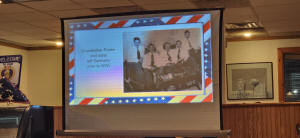
Fricke’s father, Armin Fricke, was drafted during
World War 2 immediately into the first division sent to Europe.
Because Fricke’s father had recently finished mortuary school, he
became a medic in the army. He was a first generation German
speaking and German writing officer. He went to Africa and French
Algeria with General Patton’s unit. They fought their way through
Africa, then Sicily, then Italy.
Fricke showed photos of some of the first United States flags.
The American Revolution started with the men who were coming over
from Europe.
In 1767, a general in one of the colonies got the idea that there
was too much corruption in government. They would tar and feather
people. Fricke said they needed a symbol to go by, so the first flag
was created.
The second flag was created by Colonel Forster in 1775. Fricke said
Forster was one of the colonists in the original thirteen colonies
who saw the American Revolution coming about. Colonel Moultry
created the liberty flag during this time.
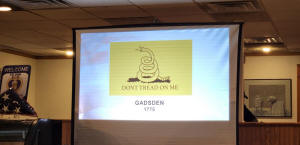
The third flag was also created in 1775. This flag
had a snake on it along with the words “Don’t Tread on Me.” Fricke
said the snake symbolized the idea of don’t bite me because I bite
back. People in the colonies were telling the King of England no
taxation without representation. If the King continued to tax the
people [without representation], Fricke said the people were letting
the King know they would bite back.
Other flags created in 1775 were the Bedford and Grand Union flags.
To appease the King, the Union Jack was put on the Grand Union flag.
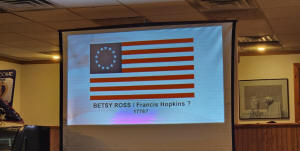
In 1776, a flag designed by Frances Hopkins and sewn
by Betsy Ross had thirteen stars and stripes representing the
colonies. Fricke said he was taught Ross had designed the flag.
The French Alliance Flag appeared in 1781 and 1782. Fricke said the
American colonists put the French emblem on it instead of stars,
which appeased the French.
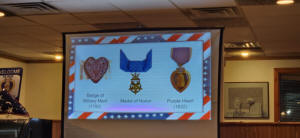
Around that time, Fricke said George Washington was a
colonel who was then appointed Commander-in-Chief of the Armed
Forces. Washington decided in a patriotic army, individual soldiers
needed to be celebrated. The commanding officer would be awarded a
medal when a battle was won, but Washington decided each soldier
should be awarded a medal.
Therefore, Fricke said, in 1782, Washington started the badge of
military merit. The badge was heart in silk on a purple background.
Another medal was the Fidelity medal, which Fricke said was awarded
to the three men who captured John Andre. Andre was the British spy
who tried to recruit Benedict Arnold into the British military and
Arnold eventually became a traitor. Fricke said this medal was never
issued again.
The military merit badge later became the Purple
Heart. Fricke’s father received a Purple Heart while on the
battlefield.
Francis Scott Key wrote the Star Spangled Banner in
1813. Though the original flag only had 13 stars and 13 stripes, two
more sates were added during the War of 1812. Fricke said the flag
then had 15 stars.
[to top of second column]
 |

Fricke next asked if anyone knew how the 21 gun
salute started. He said the 21 gun salute began as a way to honor
king or presidents.
The colonists honored everything through symbolism. Fricke said the
flag had 13 stripes and was folded 13 times. As a president came in,
Fricke said there was originally a 15 gun salute. When states were
added, it went to 16 and 17. By the time it got to 21, Fricke said
they decided not to go higher than 21.
At a military service, Fricke said there are supposed to be seven
men in a line. In the Bible, he said seven is symbolic as being a
complete series. The military would fire three times.
During the Civil War, General Donald Butterfield
would follow the commands of what was taking place in history.
Fricke said during Caesar’s time, when soldiers would retrieve the
wounded and dead off a battlefield, the men would call the soldiers’
names three times when they found someone dead.
Kings were honored with 21 guns fired separately. Fricke said when
there was a fallen man and they would shout the name three times,
Butterfield realized they were giving away their positions to their
enemies.
Butterfield was a music major and came up with an idea that followed
the French, who were then their allies. Fricke said they came up
with a musical ensemble reflecting the French’s revelry.

General Butterfield would fire guns three times and
in response, the enemies would fire guns three times indicating they
were fine with [soldiers on] the other side retrieving their dead.
Fricke said it was their way of saying, you retrieve your dead, we
will retrieve our dead. It’s a peace.
Revelry became “Taps” and Fricke said “Taps” became a replacement
for three times. Taps means rest in peace.
A 21 gun salute for a king or presidents shows the king or president
is coming. Fricke said they put arms down as a way of saying we
receive you in peace.
A seven, three volley [gun] fire replaces saying the person’s name
three times. Fricke said when you go to the next military service
and someone is playing “Taps,” in your heart you should call out
that person’s name three times.
There are seven men in a military salute rather than four, six or
eight. Fricke said guns were fired three times. Seven shots were
fired when the ship would come into port to show they came in peace.
People emptied the guns off the ship’s galley, which Fricke said
seven major cannons.
The area the ship was coming into port on showed the ship would be
received in peace. Fricke said they carried three times the amount
of cannons a ship carried, so they had twenty one.
John A. Logan of Illinois created Memorial day in 1868 to honor
those who died in the military. Fricke said at that time, the
military had not honored their dead.
By 1892, Fricke said the military thought it was good to have “Taps”
and the 21 gun salute at military funerals creating a tradition. He
said we can call it history or tradition.

When Fricke’s dad was in World War 2, he kept a
diary. One entry Fricke read mentioned a birthday party for General
Clark attended by General Bradley, General Patton, and a guy named
Bob Hope. Pin-up girl Francis Langhorne was also at the party, and
by her name, Fricke’s dad wrote oo-la-la in parentheses.
A book called A Day of Battle has a day by day diary through Africa,
Sicily and Italy. Fricke said the book mirrors what was in his
father’s diary.
A German rocket was fired right above Armin Fricke’s head, but it
did not explode. His dad received a purple heart for that.

Armin Fricke was part of the 34th Red Bull Division
that fought in the Battle of Monta Cassino. Fricke said it took
three months for the allies to take the monastery. 50,000 men lost
their lives during those months.
Fricke showed a photo of his dad’s unit and asked if anyone knew
what was going on it the photo and someone said it looked like “r
and r.” Neither Fricke nor anyone else in the family knew. Fricke
came up with the idea his dad was baptizing people.
A Day of Battle provided Fricke with a history lesson. During the
war, Allies were through Italy and Naples around the Port of Bari.
Fricke said the Germans were in retreat.
In World War I, when Germans were in retreat, Fricke said they used
mustard gas on the Allies. Many soldiers and civilians had died
because of the mustard gas.
General Dwight Eisenhower and Winston Churchill decided if the
Germans were in retreat, they might use mustard gas again. Fricke
said mustard gas was put on a ship called John Harvey. When the ship
was docked at the Port of Bari, the Germans bombed the port. He said
the bombing sank seventeen ships, damaged eight others and destroyed
38,000 tons of ammunition on supplies. John Harvey was one of the
ships hit.
Mustard gas explodes and can cause blindness. A Day of Battle says
soldiers were not to call it mustard gas, but instead call it
dysentery. Doctors did not know how to treat them.

Fricke’s father had his division wash in the lake
after being hit by the gas because he knew something was wrong.
Fricke said his father was blinded by the gas and spent 30 days in
the hospital.
The government would not tell the Allies what really happened then.
In 1967, the Freedom of Information Act was created. Fricke said
people then found that General Dwight Eisenhower and Winston
Churchill had allowed the use of Mustard Gas.
When Fricke read A Day of Battle thirty years after his father died,
he realized it was mustard gas that caused his problems.
Getting back the history of the flag, Fricke said at the time of
World War I, it had 48 stars. There were 49 stars on it by World War
2 and 50 stars by 1960.
A high school teacher in Ohio gave his students an assignment to
create something original. One of the students was named Bob Heff
and Fricke said he designed a flag. Heff’s teacher gave him a C+ on
the assignment.
However, when President Eisenhower saw the flag Heff designed,
Fricke said Eisenhower liked it. Eisenhower invited Heff to the
White House to present the flag to the nation.
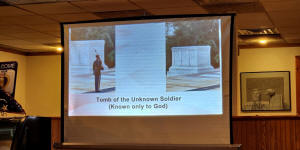
Fricke then showed a photo of the Tomb of the Unknown
Soldier. He had earlier said something was inscribed on that tomb,
but it is not in English. That stone represents all the military
veterans we don’t know by name.
After that, Fricke played a video of the Statler Brother’s song “On
the Wall,” which talks about a woman who visits the Vietnam Memorial
Wall to find her son’s name. It is a reminder that these soldiers
are more than a name on a wall.
The local American Legion and VFW honors deceased veterans. Fricke
said these organizations go through a ritual started during the
Civil War by honoring the family with a flag. Seven men do a three
volley fire for the 21 gun salute.
Fricke then had everyone stand as he showed a video of someone
playing “Taps.”
To finish out the list of words that start with the letter “F,”
Fricke added the words freedom and forgiveness.
As you sit at a cemetery reflecting on a grave of one who has played
his last tributes, Fricke said you should read these words:
“[y]ou’ve run the course, you’ve completed the race. Well done, good
and faithful servant.” You may now rest in peace through the earned
sacrifices of a veteran. Fricke said this represents freedom.
When the last trumpet or bugle sounds, you shall rise to victory
through our Lord’s sacrifice, his glory and amazing grace. Fricke
said that represents forgiveness and the ultimate sacrifice.
In 1818, ships were doing twenty gun salutes. Fricke said Illinois
became the twenty first state that year. He asked if that was a
coincidence.
With these stories, Fricke said we should decide which ones are
true, which ones are historical and which stories just happen to
coincidence.
Fricke presented the facts and some parts of history, and it is up
to us to decide whether something is coincidence or history or both.
What he does know is when there is a military salute at a service,
there is always an odd number.
With twenty one guns to welcome presidents or kings, Fricke said
each is shot one time. At the military funerals, seven guns volley
three times. Hence military history starts.
Fricke closed by thanking the veterans and the sacrifices they put
forward. People do not often realize all the sacrifices made by
veterans and he would like veterans to receive more recognition.
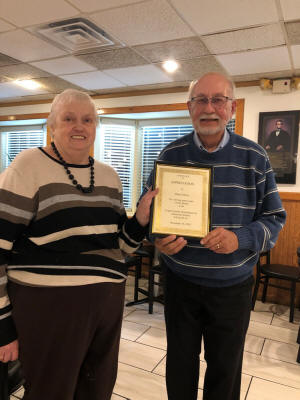
November marks the end of Diane Osborn’s term as Vice
President of the Logan County Genealogical Society, so she was
recognized for her service earlier in the evening.
In December, there will not be a LCGHS meeting. The next LCGHS
meeting will be Monday, January 20, 2025 at 6:30 p.m.
[Angela Reiners] |